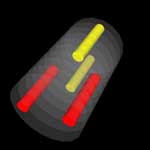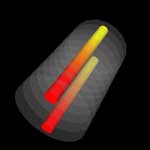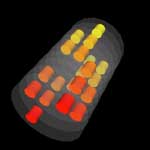|

| Title: |
Role of the short range order on the self- and
impurity diffusion of group 14 (IVB) elements with a different degree
of complexity |
| Principle investigator: |
Toshio Itami(Japan Aerospace Exploration Agency) |
| Co-investigator: |
Tadahiko Masaki |
|
Japan Aerospace Exploration Agency |
| Kozo Hoshino |
|
Hiroshima University |
| Shin'ichi Takeda |
|
Kyushu University |
| Takashi Kamiyama |
|
Hokkaido University |
| Misako Uchida |
|
Ishikawajima-Harima Heavy Industries Co., Ltd. |
 | Salient
Points and Brief Summary of the theme |
In the present study, the
diffusion coefficients in liquid germanium, whose group number in the periodic
table is the same as that of silicon, the most important industrial material,
are accurately measured in microgravity aboard the International Space Station
(ISS).
Constituent atoms in liquids are continuously moving and their
migrations are influenced by frequent collisions among them. At present, it is
hardly possible to directly observe such complex atomic motion in melts. The diffusion
coefficient is a measure of the average migration distance of these atoms in a
given time. Therefore, it is possible to obtain important information about atomic
motion by accurately measuring the diffusion coefficient. Generally, two kinds
of liquids are caused to contact each other and the development of atomic mixing
with the lapse of time is investigated to measure diffusion coefficients in melts.
However, in previous studies, it was difficult to accurately measure this development
in melts of metals and semiconductors because convection caused by even small
temperature differences in such melts at high temperatures spoils this development.
Microgravity suppresses convection and enables us to accurately measure the diffusion
coefficient in high-temperature melts. The present experiment employs a mirror
furnace with an X-ray observation system. Directly observing the liquid state
of a diffusion sample during diffusion experiments by an X-ray image assures the
successful performance of the diffusion experiments for high-temperature melts.
The obtained result from the present experiment not only contributes acquiring
new fundamental information about atomic motion in melts but also provides precious
information for applications to improve the homogeneity of impurity concentrations
in semiconductor materials, which is important for producing high-quality semiconductor
crystals.
 |  |  | Before
diffusion | During diffusion |
After diffusion | | (Separated
state of liquid diffusion column) | (Formation
of liquid diffusion column) | (Sectioning
of liquid diffusion column) |
 | Requires
QuickTime.
Tune
your QuickTime plug-in.
1. Select Plug-in Settings
(on the control bar pop-up
menu.)
2. Click on the Connection Speeds button.
3. Select the type of modem
or connection you use.
4. Save settings.
5. Reload the page to play at your
connection speed. |
Last Updated : October 1, 2003
|
